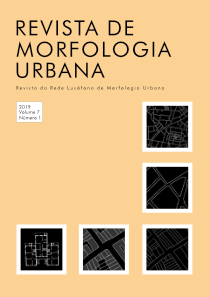Resumo
Esta pesquisa traz uma abordagem sobre as qualidades espaciais da cidade e seu efeito sobre a sociabilidade urbana a partir de um estudo de caso de caráter exploratório de uma localidade do Recife-PE, Brasil. Esta cidade vem experimentando uma alta verticalização e adensamento de certas áreas da cidade, o aumento de interfaces fechadas e pouca diversidade de usos do solo. Diante disso nos perguntamos: Até que ponto a configuração espacial pode influenciar nos tipos de encontros entre os indivíduos que levam à sociabilidade urbana? A partir disso, o objetivo desta pesquisa é identificar quais parâmetros morfológicos e sociais de uma vizinhança teriam correlação com uma maior sociabilidade urbana. Para o desenvolvimento se estuda o surgimento de um padrão social através de um questionário sobre sociabilidade urbana, elaborado a partir da teoria das facetas, e se analisam as qualidades espaciais do segmento de rua onde os entrevistados residem, utilizando a metodologia do perfil espacial. Esta investigação pretende desvendar como essas qualidades espaciais e sociais podem rebater na sociabilidade urbana e, desta forma, descrever aqueles aspectos morfológicos necessários para conseguir uma boa qualidade urbana na cidade do Recife.
Referências
Bulmer, M. (1986) Neighbours: The work of Philip Abrams. Primera ed. Cambridge, Cambridge University Press.
Canter, D. (1983) The purposive Evaluation of Places - A Facet Approach. Environment and Behaviour, 15(6), 659-698.
Cavalcanti, R. (2013) Espaço e crime: Desvendando a lógica dos padrões espaciais de crimes urbanos no bairro de Boa Viagem, Recife-PE. Recife: Dissertação, MDU-UFPE.
Guttman, L. (1957) Introduction of Facet Design and Analysis. Proceedings of the Fifth International Congress of Psychology, Brussels. Amsterdam, North Holland Publishing Co.
Hanson, J. (2000) Urban transformations: a history of design ideas. Urban Design International, 5(2), 97-122.
Hillier, B. e Hanson, J. (1984) The social logic of space. Londres, Cambridge University Press.
Hillier, B. (1989) The Architecture of the urban object. Ekistics, 334/335, 5-21.
Holanda, F. (2002) O espaço de exceção. Brasília, UnB.
Jacques, P., 2008. Corpografias urbanas. Arquitextos, 093.07. Disponível em: http://www.vitruvius.com.br/ revistas/ read/arquitextos/08.093/165 [Acesso em 24 Janeiro 2019].
Legeby, A. (2013) Patterns of co-presence: Spatial configuration and social segregation. Stockholm, School of Architecture. Royal Institute of Technology (PhD Dissertation).
Lopes, A. (2001) Relações de vizinhança no espaço dos apartamentos. Recife (Dissertação, MDU, UFPE): s.n.
Lopes, A. (2008) Condomínios residenciais: Novas faces da sociabilidade e da vivência de transgressões sociais. Recife: Tese, MDU UFPE.
Monteiro, C. (1989) The experience of Place: a comparative analysis of middle class neighborhoods, public housing estates and favela in Brazil. Oxford, University of Oxford.
Monteiro, C. (2010) Spatial Analysis od Street Crimes. Em: Shoham, S. G.; Knepper, P.; Kett, M. (eds.) International Handbook of criminology. s.l.:CRC Press, pp. 619-648.
Monteiro, C. e Cavalcanti, R. (2017) Perfis espaciais urbanos para avaliação de lugares vulneráveis ao crime. Em: Netto, V.M., Saboya, R.T., Vargas, J.C. e Carvalho, T. (eds.) Efeitos da arquitetura: os impactos da urbanização contemporânea no Brasil. Brasília: FRBH Edições, pp. 137-161.
Netto, V. M. (2016) A cidade como resultado. Em: Balbim, R., Krause, C. e Linke, C. (eds.) Cidade e movimento: Mobilidades e Interações no Desenvolvimento Urbano. Brasília, Instituto de Pesquisa Econômica Aplicada - IPEA, pp. 101-130.
Netto, V. M. (2016) The social fabric of cities. London, Routledge.
Netto, V. M., Vargas, J. e Saboya, R. (2012) (Buscando) os efeitos sociais na morfologia arquitetônica. Urbe. Revista Brasileira de Gestão Urbana, jul./dez., 4(2), pp. 261-282.
Olagnero, M., Torrioni, P. e Saraceno, C. (2007) Patterns of sociability in the enlarged EU. Em: Alber, J., Fahey, T. e Saraceno (eds.) Handbook of Quality of Life in the Enlarged European Union. New York, Routledge.
Saboya, R., Netto, V. M. e Vargas, J. (2015) Fatores morfológicos da vitalidade urbana: uma investigação sobre o tipo arquitetônico e seus efeitos. Arquitextos, 180.2. Disponível em http://vitruvius.com.br/revistas/read/ arquitextos/15.180/5554 [Acesso em 07 Agosto 2019].
Os direitos autorais permanecem com os autores, que autorizam a Revista de Morfologia Urbana a publicar o artigo sob uma licença Creative Commons Atribuição (CC-By).


